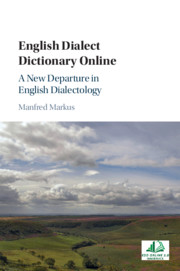Book contents
- English Dialect Dictionary Online
- English Dialect Dictionary Online
- Copyright page
- Contents
- Figures
- Tables
- Preface
- Acknowledgements
- Note on the Text
- 1 Introduction
- 2 Orthography
- 3 Tagging
- 4 The Syntax of EDD Entries, and How to Describe It
- 5 Some Practical Suggestions in Hindsight
- 6 The Interface
- 7 Retrieval Window (Advanced Mode)
- 8 Research Issues Encouraged by EDD Online
- 9 Focus on Quantification
- 10 Final Remarks on the Accessibility and Impact of EDD Online
- Appendix
- References
- Index
2 - Orthography
Published online by Cambridge University Press: 28 January 2021
- English Dialect Dictionary Online
- English Dialect Dictionary Online
- Copyright page
- Contents
- Figures
- Tables
- Preface
- Acknowledgements
- Note on the Text
- 1 Introduction
- 2 Orthography
- 3 Tagging
- 4 The Syntax of EDD Entries, and How to Describe It
- 5 Some Practical Suggestions in Hindsight
- 6 The Interface
- 7 Retrieval Window (Advanced Mode)
- 8 Research Issues Encouraged by EDD Online
- 9 Focus on Quantification
- 10 Final Remarks on the Accessibility and Impact of EDD Online
- Appendix
- References
- Index
Summary
We have tried to keep orthographic mistakes to a minimum by creating first a machine-scanned version of the whole text (in fact, the one used in the project SPEED, alias EDD Online 1.0) and then a double-typed version – typed by employees of a firm in China. The three versions were then automatically compared (by Hans-Werner Bartz of the University of Trier, later of the Akademie der Wissenschaften in Darmstadt, Germany), with a protocol listing the deviant passages so that we could check these passages and correct the mistakes manually. Generally, the mistakes made by the machine were different in type from the mistakes of the human typists. But talking about their mistakes, one should mention that the Chinese typists seemed to have a specific sense of deciphering subtle differences in graphic signs (which is what Chinese spelling consists of), in my opinion, more than educated European typists would, whose minds would probably have read and typed texts based on some sensible (but possibly incorrect) interpretation of words. The EDD, of course, created specific problems of spelling semiotics: phonetic transcriptions (of a kind unknown today), with many special characters; pseudo-phonetic spellings (as were widely, but inconsistently common in nineteenth-century Britain); and, last but not least, problems caused by the wide use of abbreviations and the separation of words in line-, column- and page-breaks.
- Type
- Chapter
- Information
- English Dialect Dictionary OnlineA New Departure in English Dialectology, pp. 7 - 11Publisher: Cambridge University PressPrint publication year: 2021

